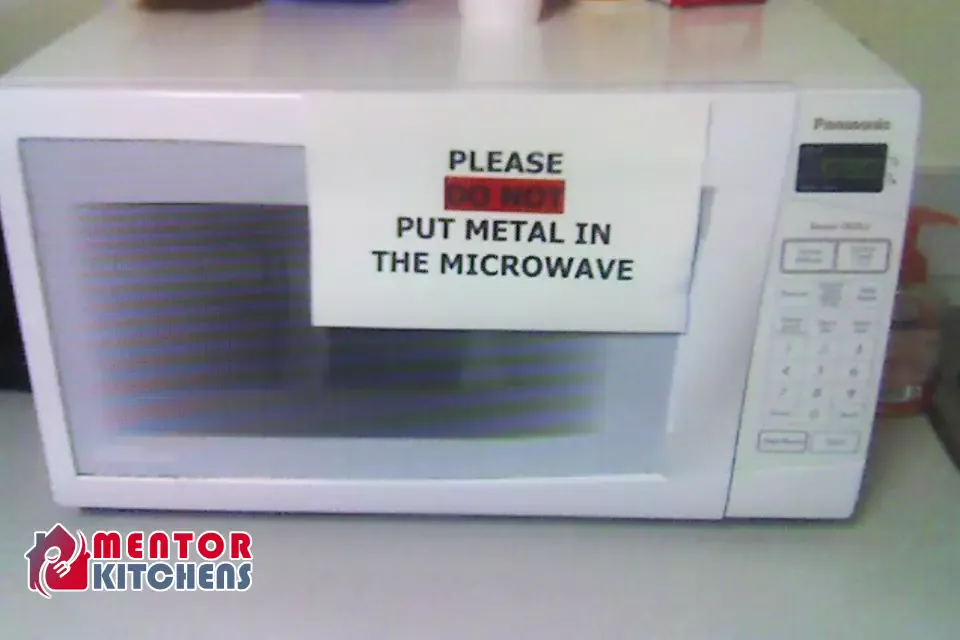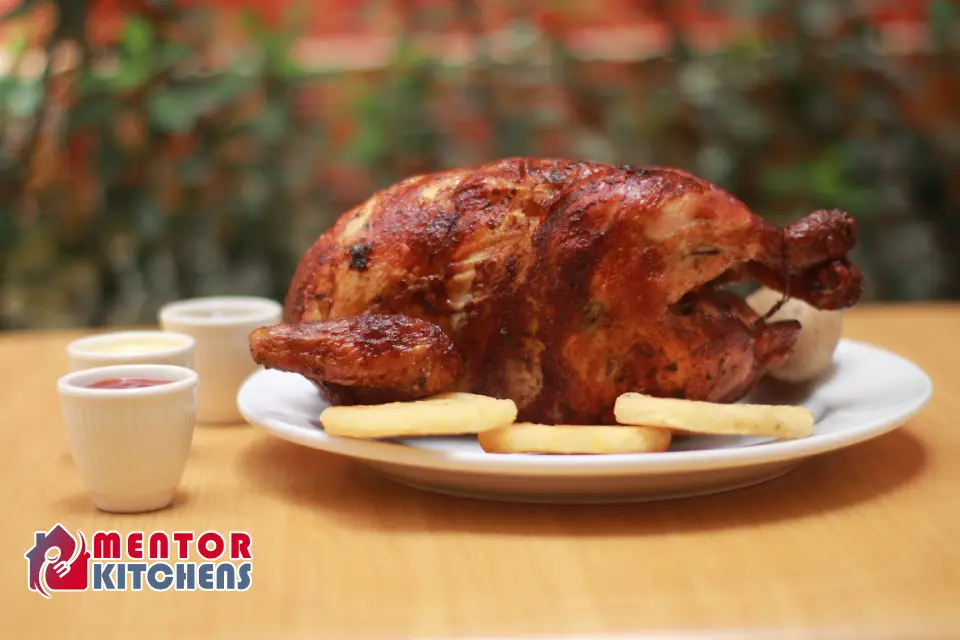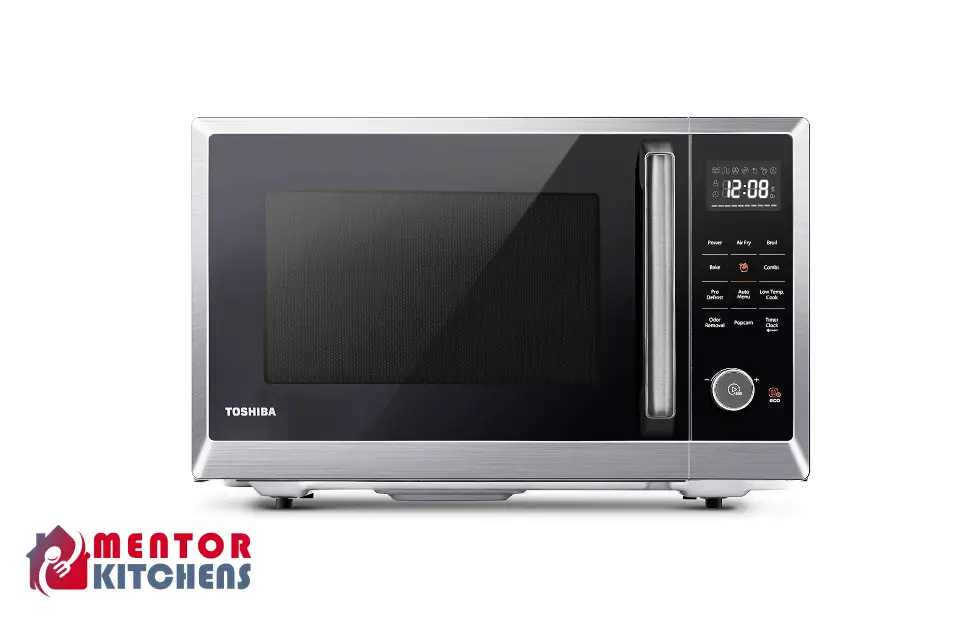Have you ever wondered if you can put a metal bowl in the microwave? This is a common question that many people ask, and the answer is not as straightforward as you might think.
While it is generally not recommended to put metal in the microwave, there are some exceptions to this rule.
In this article, we will provide you with a detailed guide on whether or not you can put a metal bowl in the microwave.
Understanding Microwaves and Metal

First things first, let’s talk about how microwaves work. Microwaves are a type of electromagnetic radiation used to heat food in your microwave oven. These waves are absorbed by the food, making water molecules inside it vibrate and generate heat. This efficient process is why microwaves are our go-to choice for quick heating.
But why should you avoid metal in the microwave? Well, when metal is placed in a microwave, it disrupts this process. Instead of heating your food, the microwaves bounce off the metal’s surface. This can cause the metal to heat up rapidly, possibly leading to a fire or damaging your microwave.
It’s essential to remember that not all metals react the same way to microwaves. Thin metals like aluminum foil can spark, while thicker metals like stainless steel might not spark but can still damage the microwave.
As a general rule, it’s best to steer clear of putting any metal in the microwave. However, if you must, make sure it’s explicitly labeled as microwave-safe and follow the manufacturer’s instructions carefully.
The Science Behind Microwaving Metal
Let’s dive a bit deeper into the science. At a microscopic level, metal consists of tiny particles that vibrate constantly. When these particles encounter the microwave’s electromagnetic waves, they start vibrating more rapidly, generating heat within the metal. This increased heat can make the metal extremely hot, potentially leading to a fire or even an explosion.
Remember, different metals react differently to microwaves. Thin metals like aluminum foil can’t generate enough heat to cause issues, but they can spark. Thicker metals like stainless steel may not spark but can cause arcing, where electrical current jumps between points, creating a spark and potential hazards.
I’ve tried to explain it in an easy way, but if you want to delve into the scientific language and explore this topic further, you can read this article: What’s Up With That: Metal in the Microwave Explodes—Or Does It?
You may also like to read: Is Pyrex Microwave Safe? Risks and Safety
Effects of Microwaving Metal Bowls
Microwaving a metal bowl can have various effects, depending on the type of metal and the shape of the bowl. Here are some of the effects that you may experience if you put a metal bowl in the microwave:
- Sparks: Metal is an excellent conductor of electricity, and microwaves use high-frequency electromagnetic waves to heat food. When microwaves encounter metal, they can cause sparks to fly, which can damage the interior of your microwave and create a fire hazard.
- Arcing: Arcing occurs when the microwaves cause a spark to jump between two points on the metal surface. This can create a loud buzzing or crackling sound and can cause damage to your microwave.
- Fire: If the sparks or arcing are severe enough, they can ignite a fire in your microwave. This can be dangerous and can cause damage to your kitchen.
- Damage to the Microwave: Even if there is no fire, microwaving a metal bowl can cause damage to your microwave. The sparks and arcing can create small pits and scratches on the interior of your microwave, which can make it more difficult to clean and can reduce its lifespan.
In summary, microwaving a metal bowl can be dangerous and can cause damage to your microwave. It is best to avoid putting metal bowls in the microwave and to use microwave-safe containers instead.
Safety Measures When Microwaving Metal
Microwaving metal can be dangerous and cause serious damage to your microwave or even start a fire. It is important to follow safety measures when microwaving metal to avoid any potential hazards.
Firstly, never put any metal objects in the microwave unless it is explicitly stated that it is safe to do so. Always check the manufacturer’s instructions before putting any metal in the microwave.
Secondly, if you accidentally put metal in the microwave and it starts to spark or create a fire, immediately turn off the microwave and unplug it. Do not open the microwave door until the fire is completely out and the microwave has cooled down.
Thirdly, always use microwave-safe containers when heating up food in the microwave. These containers are made from materials that are safe to use in the microwave and will not cause any harm or damage.
Lastly, never use aluminum foil or metal utensils in the microwave. Aluminum foil can cause a fire and metal utensils can create sparks, which can damage the microwave and be harmful to you.
By following these safety measures, you can ensure that you use your microwave safely and avoid any potential hazards when microwaving metal.
Alternatives to Metal Bowls for Microwaving
If you’re looking for alternatives to metal bowls for microwaving, there are several options available:
Glass Bowls
Glass bowls are a great alternative to metal bowls for microwaving. They are microwave-safe and won’t interfere with the microwaves, so your food will heat evenly. Glass bowls are also convenient because they can go from the microwave to the table, making them great for serving.
Ceramic Bowls
Ceramic bowls are another good option for microwaving. They are microwave-safe and won’t affect the microwaves, so your food will cook evenly. Ceramic bowls are also great for serving, as they come in a variety of colors and designs.
Plastic Bowls
Plastic bowls are microwave-safe, but you need to make sure they are labeled as such. Some plastic bowls can release harmful chemicals when heated, so it’s important to choose a microwave-safe plastic bowl. Plastic bowls are also lightweight and durable, making them great for everyday use.
Paper Bowls
Paper bowls are microwave-safe, but they are not as durable as other options. They are great for heating up leftovers or cooking a quick meal, but they may not hold up well if you need to use them frequently.
Silicone Bowls
Silicone bowls are microwave-safe and won’t interfere with the microwaves. They are also flexible and easy to clean, making them a great option for microwaving. Silicone bowls are also great for storage, as they can be collapsed and stored in a small space.
You may also like to read: 6 Best Microwavable Soup Containers 2023
Overall, there are many alternatives to metal bowls for microwaving. Whether you choose glass, ceramic, plastic, paper, or silicone, make sure the bowl is labeled as microwave-safe to ensure safe and even cooking.
Conclusion
In conclusion, while it may be tempting to use a metal bowl in the microwave, it is not recommended for safety reasons. Metal can cause sparks and even start a fire when exposed to the electromagnetic radiation produced by the microwave.
To avoid any potential hazards, it is best to use microwave-safe containers made of glass, ceramic, or plastic when heating food in the microwave. Always check the label or manufacturer’s instructions to ensure that the container is safe to use in the microwave.
Remember, safety should always come first when using any kitchen appliance. By following these guidelines, you can safely and efficiently heat your food in the microwave without any risk of damage or injury.
Frequently Asked Questions:
Can You Put a Metal Bowl on the Stove?
No, you should not put a metal bowl on the stove. Metal is a conductor of heat, which means that it will get hot quickly and can cause burns or even start a fire if left on the stove. Instead, use a pot or pan made of a heat-resistant material like stainless steel or ceramic.
Can I Put a Plastic Bowl in the Microwave?
It depends on the type of plastic. Some plastics are microwave-safe, while others can melt or release harmful chemicals when heated. Look for microwave-safe symbols on the bottom of the bowl or container before putting it in the microwave. If there is no symbol, it is best to avoid using it in the microwave.
What Kind of Bowls Are Microwave-safe?
Microwave-safe bowls are typically made of glass, ceramic, or plastic that is labeled as microwave-safe. Avoid using metal, aluminum foil, or anything with metallic accents in the microwave.
Can You Heat Metal Bowls?
Yes, you can heat metal bowls, but only if they are microwave-safe. Look for bowls made of stainless steel or other materials that are labeled as safe for use in the microwave. Avoid using aluminum foil or other metal objects in the microwave, as they can cause sparks or fires.
Can You Put Stainless Steel in the Microwave?
Yes, you can put stainless steel in the microwave, but only if it is labeled as safe for use in the microwave. Some stainless steel bowls and utensils may have metallic accents that can cause sparks or fires in the microwave, so be sure to check the label before using them.
What Happens If You Put a Stainless Steel Bowl in the Microwave?
If you put a stainless steel bowl in the microwave that is not labeled as safe for use, it can cause sparks or a fire. The metal can also heat up quickly and cause burns if you try to handle it. Always check the label before using any metal objects in the microwave.
Are Stainless Steel Mixing Bowls Microwave Safe?
Some stainless steel mixing bowls may be microwave-safe, but it is important to check the label before using them in the microwave. Look for bowls that are labeled as microwave-safe or heat-resistant to ensure that they will not cause sparks or fires in the microwave.



Leave a Reply